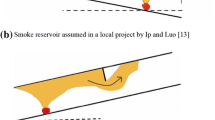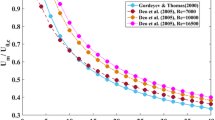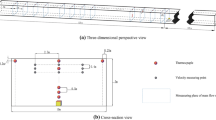Abstract
Computational Fluid Dynamics (CFD) simulation results, obtained with Fire Dynamics Simulator (FDS 6.0.1), are presented in order to analyze the performance of an air curtain in blocking fire-induced smoke in a tunnel configuration. The flow and temperature fields are discussed for different air curtain jet velocities and for a range of smoke inlet temperatures. The key objective is the determination of the effectiveness of a vertical air curtain in blocking the fire-induced smoke spreading downstream of the air curtain, as function of the momentum of the air curtain. The results are presented in non-dimensional form, in terms of a ‘momentum ratio’ R, defined as \( R = \frac{{\rho_{j} A_{j} V_{j}^{2} }}{{\rho_{s} A_{s} V_{s}^{2} }} \). This is the ratio of the vertically downward air curtain momentum to the horizontal smoke layer momentum at the position of the air curtain. This allows interpretation of the results, obtained at reduced-scale, in full-scale configurations. The smoke blocking is quantified by means of sealing effectiveness E, defined as one minus the ratio of the average temperature increase in the region downstream of the air curtain to the average temperature increase in the same region without activated air curtain. For small values of R, the sealing effectiveness E increases as the momentum ratio R increases. A maximum sealing effectiveness, E ≈ 60%, is attained for R = 8–10. Higher values of R lead to less effective sealing because the downward impinging air flow pushes smoke into the downward region. For very high values of R the effectiveness increases again, due to dilution of the smoke pushed in the downward region.













Similar content being viewed by others
References
Sakurai H, Hayashi T, Shibata M, Kanehara K (1980) Researches on air shutter for fire defence. Fire Saf J 2(1):9–16. doi:10.1016/0379-7112(79)90011-0
Etkin B, Goering PLE (1971) Air-curtain walls and roofs-‘Dynamic’ structures. Philos Trans R Soc Lond Ser A Math Phys Sci 269(1199):527–543. doi:10.1098/rsta.1971.0050
Frank D, Linden PF (2014) The effectiveness of an air curtain in the doorway of a ventilated building. J Fluid Mech 756:130–164. doi:10.1017/jfm.2014.433
Foster AM (2007) CFD optimization of air movement through doorways in refrigerated rooms. In: Computational fluid dynamics in food processing. Contemporary food engineering. CRC Press, pp 167–193. doi:10.1201/9781420009217.ch7
Guyonnaud L, Solliec C, de Virel MD, Rey C (2000) Design of air curtains used for area confinement in tunnels. Exp Fluids 28(4):377–384. doi:10.1007/s003480050397
Elicer-Cortés JC, Demarco R, Valencia A, Pavageau M (2009) Heat confinement in tunnels between two double-stream twin-jet air curtains. Int Commun Heat Mass Transfer 36(5):438–444. doi:10.1016/j.icheatmasstransfer.2009.01.019
McGrattan KB, Hostikka S, Floyd J (2015) Fire dynamics simulator, user’s guide. NIST Special Publication 1019, 6th edn. National Institute of Standards and Technology, USA. doi:10.6028/NIST.SP.1019
Hu LH, Fong NK, Yang LZ, Chow WK, Li YZ, Huo R (2007) Modeling fire-induced smoke spread and carbon monoxide transportation in a long channel: fire dynamics simulator comparisons with measured data. J Hazard Mater 140(1–2):293–298. doi:10.1016/j.jhazmat.2006.08.075
Luo N, Li A, Gao R, Zhang W, Tian Z (2013) An experiment and simulation of smoke confinement utilizing an air curtain. Saf Sci 59(0):10–18. doi:10.1016/j.ssci.2013.04.009
Debeer C (2015) Low speed wind tunnel L-2B. Vki.ac.be.https://www.vki.ac.be/index.php/research-consulting-mainmenu-107/facilities-other-menu-148/low-speed-wt-other-menu-151/60-low-speed-wind-tunnel-l-2b. Accessed 6 July 2015
Horvath IA, Buchlin J-M (2012) Extreme PIV applications: simultaneous and instantaneous velocity and concentration measurements on model and real scale car park fire scenarios. Rhode-St-Genèse, Belgium
Yu L-X, Liu F, Merci B (2015) Analysis of the impact of the inlet boundary conditions in FDS results for air curtain flows in the near-field region, Ninth Mediterranean Combustion Symposium. Rhodes, Greece
Munson BR, Young DF, Okiishi TH (1990) Fundamentals of fluid mechanics. Wiley, New York
Jarrin N, Prosser R (2008) Synthetic inflow boundary conditions for the numerical simulation of turbulence. University of Manchester
Tilley N, Rauwoens P, Merci B (2011) Verification of the accuracy of CFD simulations in small-scale tunnel and atrium fire configurations. Fire Saf J 46(4):186–193. doi:10.1016/j.firesaf.2011.01.007
McGrattan K, Hostikka S, Floyd J, Mell W, McDermott R (2015) Fire dynamics simulator, technical reference guide, volume 1: mathematical model. NIST Special Publication 1018, 6th edn. National Institute of Standards and Technology, USA. doi:10.6028/NIST.SP.1018-1
Alpert RL (2002) Ceiling jet flows. In: SFPE handbook of fire protection engineering, 3rd edn. National Fire Protection Association, Massachusetts, pp 2-18-12-31. doi:10.1007/978-1-4939-2565-0
Costa J, Oliveira L, Silva M (2006) Energy savings by aerodynamic sealing with a downward-blowing plane air curtain—a numerical approach. Energy Build 38(10):1182–1193. doi:10.1016/j.enbuild.2006.02.003
Acknowledgments
This research has been conducted at Ghent University, supported by the State Scholarship Fund of China under Grant No. 201306050081 and Chongqing Graduate Student Research Innovation Project under Grant No. CYB14031. Dr. Tarek Beji is Postdoctoral Fellow of the Fund of Scientific Research—Flanders (Belgium) (FWO-Vlaanderen). The computational resources (Stevin Supercomputer Infrastructure) and services used in this work were provided by the VSC (Flemish Supercomputer Center), funded by Ghent University, the Hercules Foundation and the Flemish Government—department EWI.
Author information
Authors and Affiliations
Corresponding author
Rights and permissions
About this article
Cite this article
Yu, LX., Beji, T., Zadeh, S.E. et al. Simulations of Smoke Flow Fields in a Wind Tunnel Under the Effect of an Air Curtain for Smoke Confinement. Fire Technol 52, 2007–2026 (2016). https://doi.org/10.1007/s10694-016-0598-y
Received:
Accepted:
Published:
Issue Date:
DOI: https://doi.org/10.1007/s10694-016-0598-y




